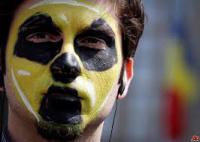Buried in Australia's soil is a third of Earth's uranium, the largest reserve in the world. This means there's big money in mining it. But standing on it are Indigenous Australians with native title rights to that land. The Martu people, only numbering only around 1,000, own around 136,000 square kilometres in Western Australia. On the other side of the dispute is the world's largest uranium company Cameco, an industry leading uranium and processing services company headquartered in Canada, which in collaboration with Mitsubishi, want to extend the Kintyre mine in the East Pilbara region of Western Australia. It bears the name of an area cut out of WA’s largest and most remote national park for mining in 1994.
Darren Farmer, a burly middle-aged Martu tribal man, told VICE online magazine that "the Martu people do not want this uranium mine. Everybody has said no." But that hasn't stopped the federal environment minister Greg Hunt from giving Kintyre the green light.
The VICE article explains how poverty prompts some Martu to agree to mining on their country and how Darren Farmer and others are physically assaulted for opposing it.
Meanwhile four decades after test explosions of atom bombs in the Maralinga desert area of South Australia, which killed and maimed Aboriginal people, Indigenous people face barriers as they try to contribute to a parliamentary inquiry whether the state should start a nuclear fuel cycle industry.
A requirement for all submissions to be sworn in front of a justice of the peace makes it particularly difficult for Aboriginal people, people from remote areas and those with language issues to present their views.
The former Governor [Queen Elizabeth’s representative] of South Australia, Kevin Scarce, who heads the inquiry, is to inspect the Fukushima region of Japan, ravaged by nuclear reactor explosions.
One of the things the inquiry will consider is the storage of nuclear waste from other countries. The federal government is currently looking for a site to dump six cubic metres of nuclear waste that must return to Australia from France for processing this year.
The federal government had previously targeted Aboriginal-owned sites in the Northern Territory, including Muckaty Station, where agreements with Aboriginal governance fell through or stalled. Aboriginal women’s resistance also stopped a 2003 plan by the federal government to dump nuclear waste in South Australia.
The French state-owned nuclear giant Areva is offering to sell its 'world leading' nuclear technology to South Australia. “The offer is being reported in the South Australian media without a hint of irony,” comments leading anti-nuclear Australian activist, Jim Green. “A reality check is in order.”
Two former Australian prime ministers, one each from the Liberal [in name only, actually right-of-centre conservative] and Labor [only nominally left] parties have said it would be a good idea for Australia to take in all the world’s nuclear waste. Guess on whose lands.....
Other Australian nuclear references:
Even if strict safeguards were in place, uranium sales to India would create intractable problems through uranium exports freeing up India's domestic reserves for weapons production.
Groups concerned about security, safety and environmental aspects of the controversial plan to sell India Australian uranium have been giving putting their arguments.

